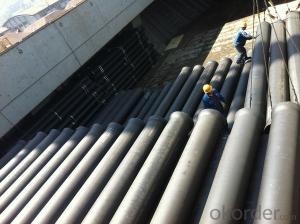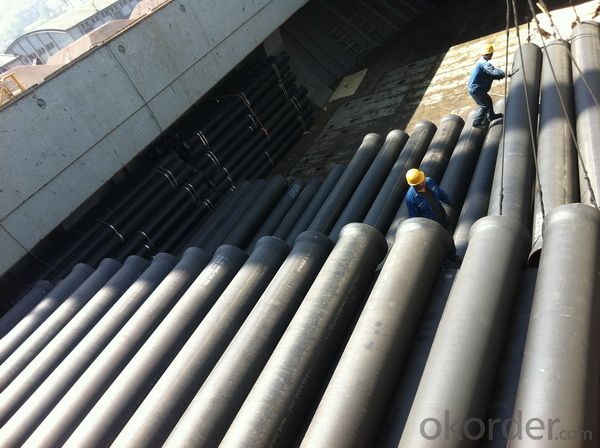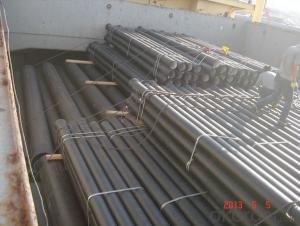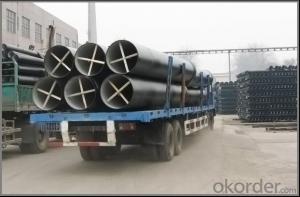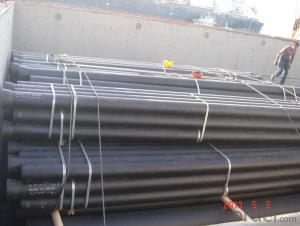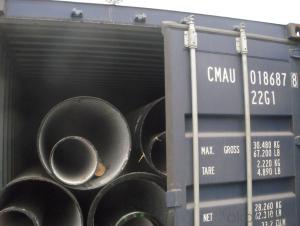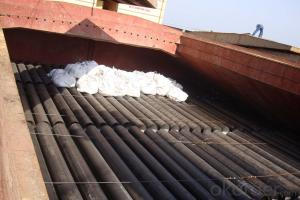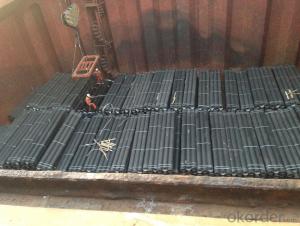K Type Ductile Iron Pipe DN200 SOCKET SPIGOT PIPE
- Loading Port:
- Tianjin
- Payment Terms:
- TT OR LC
- Min Order Qty:
- 200 m
- Supply Capability:
- 80000 m/month
OKorder Service Pledge
OKorder Financial Service
You Might Also Like
1) The standard of pipe: ISO2531:1998, EN545:2006,K9 K8
2) Effective length: 6m/5.7m
3) Inner cement line: Portland cement lineas per ISO4179
4) Zinc coating: at least 130g/m2 as per ISO8179
5) Bitumen painting: at least 70μm as per ISO8179
6)With 102% quantity of NBR, SBR, or EPDM ring asper ISO4633
7) DN80-DN1200
8) Highstrength, lighter than grey iron, good corrosion resistance, no furring, smallflow resistance, easy fixing, long life tome about 100 yeas
9)Checked by automatic inspection equipment
10) Composition:
Chemical composition | |||
Chemical composition | Ductile Cast Iron Pipe (%) | Grey iron pipe (%) | Steel pipe (%) |
C | 3.5-4.0 | 3.2-3.8 | 0.1-0.2 |
Si | 1.9-2.6 | 1.4-2.2 | 0.15-0.4 |
Mn | 0.15-0.45 | 0.4-0.6 | 0.3-0.6 |
P | ≤0.06 | ≤0.3 | 0.02-0.03 |
S | ≤0.02 | ≤0.1 | 0.02-0.03 |
Mg | 0.03-0.06 |
|
|
11) Feature:
Mechanical properties | |||
| Ductile Cast Iron Pipe | Grey Iron Pipe | Steel Pipe |
Tensile Strength(Mpa) | ≥420 | 150-260 | ≥400 |
Yield Strength(Mpa) | ≥300 | No Confirmation | No Confirmation |
Bending Strength(Mpa) | ≥590 | 200-360 | ≥400 |
Elongation (%) | ≥10 | Neglected | ≥18 |
Brinell Hardness(HBS) | ≤230 | ≤230 | About 140 |
12) T type mechanical joint
13) Packing: in bulk or container
PACKING: 1) Pipesare bundled together with the steel belt.
2) Wooden pieces are put between the pipes.
- Q: How do ductile iron pipes handle pressure surges in pumping stations?
- Ductile iron pipes excel at effectively managing pressure surges in pumping stations. The exceptional strength and flexibility of ductile iron make it an excellent choice for withstanding sudden increases in pressure that can occur during pump start-up or shutdown. One of the standout qualities of ductile iron pipes is their remarkable capacity to absorb and distribute energy. When a pressure surge arises, these pipes can absorb the excess pressure and evenly distribute it throughout the pipe network. This capability greatly reduces the impact of the surge and safeguards against potential damage to the pipes or pumping station. Furthermore, ductile iron pipes possess a high resistance to impact and stress, which further bolsters their ability to handle pressure surges. Their manufacturing process imparts a unique strength and durability that allows them to endure the forces exerted during pressure fluctuations without significant deformation or failure. Moreover, ductile iron pipes boast a smooth internal surface that minimizes friction and turbulence within the pipe network. This smooth flow characteristic helps mitigate the effects of pressure surges by ensuring efficient movement of water without placing additional stress on the pipes. In conclusion, ductile iron pipes are meticulously engineered to handle pressure surges in pumping stations. They excel at absorbing and dissipating excess pressure, enduring impact and stress, and promoting smooth flow. Their robustness and reliability make them the ideal choice for applications where pressure fluctuations are prevalent, guaranteeing the longevity and efficiency of pumping infrastructure.
- Q: What is the difference between spheroidal graphite cast iron QT400-15 and QT400-15A? What does the A mean later?
- The front is the material grade, and the back of the A should have special requirements.
- Q: What are the common methods for flow control in ductile iron pipes?
- There are several common methods for flow control in ductile iron pipes. One of the most commonly used methods is the installation of valves. Valves can be used to regulate the flow of water or other fluids through the pipes. They can be manually operated or automated, depending on the specific needs of the system. Another method for flow control in ductile iron pipes is the use of flow restrictors or flow limiters. These devices are installed in the pipes to reduce the flow rate and ensure that the system operates within its designed parameters. Flow restrictors can be useful in situations where the flow needs to be controlled to prevent damage or to optimize the efficiency of the system. Flow control can also be achieved through the use of pressure regulators. These devices are installed in the pipes to maintain a specific pressure level within the system. Pressure regulators can help prevent excessive pressure, which can lead to pipe bursts or other damage. They can also help maintain a consistent pressure throughout the system, ensuring that the flow is controlled and predictable. Additionally, flow control can be achieved through the use of flow meters. These devices are installed in the pipes to measure the flow rate of the fluid passing through them. By monitoring the flow rate, operators can adjust valves or other flow control devices to ensure that the flow is within the desired range. Flow meters are particularly useful in applications where accurate flow measurement is crucial, such as in industrial processes or water distribution systems. Overall, the common methods for flow control in ductile iron pipes include the use of valves, flow restrictors, pressure regulators, and flow meters. These methods can be combined or used individually depending on the specific requirements of the system.
- Q: DN300 what's the price of the ductile iron pipe / the weight and the price of one meter?
- Ductile iron pipe is a kind of cast iron. It is an alloy of iron, carbon and silicon.
- Q: How does ductile iron pipe perform in areas with high groundwater salinity?
- Ductile iron pipe performs well in areas with high groundwater salinity due to its corrosion resistance properties. The iron pipe is coated with a protective layer that prevents corrosion and extends its lifespan, even in saline environments.
- Q: What is the expected internal lining material for ductile iron pipes?
- The expected internal lining material for ductile iron pipes is typically cement mortar or polyethylene.
- Q: Are ductile iron pipes resistant to chloride-induced corrosion?
- Yes, ductile iron pipes are resistant to chloride-induced corrosion. Ductile iron is a type of cast iron that has been treated with magnesium to make it more flexible and resistant to cracking. It has a ferritic microstructure which provides excellent resistance to corrosion caused by chlorides. Chloride-induced corrosion can occur when chloride ions in the water or soil come into contact with the metal surface, leading to the formation of corrosion products such as rust. However, the presence of magnesium in ductile iron forms a protective layer on the surface, preventing the chloride ions from reaching the metal and thus inhibiting corrosion. This makes ductile iron pipes suitable for a wide range of applications, including water supply and sewerage systems, where chloride exposure is common.
- Q: Why does the cast iron pipe always run off when testing?
- The pipeline is installed, straight section of each pipe will be added pier, concrete pipe, elbow, three links should also have concrete pier, specific installation method according to GB Atlas 03SS515, and the straight pipe to soil, pipeline interface will be exposed, easy to check.
- Q: Can ductile iron pipe be used in high-pressure applications?
- Yes, ductile iron pipe can be used in high-pressure applications. Ductile iron pipe has excellent tensile strength and is capable of withstanding high pressure levels. It is often used in water and wastewater systems, as well as in oil and gas pipelines where high-pressure conditions are present.
- Q: What is the expected external protection system for ductile iron pipes?
- The expected external protection system for ductile iron pipes typically includes a combination of coatings and cathodic protection. Coatings, such as fusion-bonded epoxy (FBE) or polyethylene, are applied to the external surface of the pipe to provide a barrier against corrosion and protect it from the surrounding environment. These coatings are highly resistant to moisture, chemicals, and abrasion, ensuring the longevity of the pipe. In addition to coatings, cathodic protection is often employed to further enhance the external protection of ductile iron pipes. Cathodic protection involves the use of sacrificial anodes or impressed current systems to create a protective electrical current that counteracts the corrosive effects on the pipe's surface. This technique helps prevent corrosion by ensuring that the ductile iron remains in a cathodic state, where it is less prone to degradation. The combination of coatings and cathodic protection provides a robust and comprehensive external protection system for ductile iron pipes. These measures effectively safeguard the pipes from corrosion, extending their service life and minimizing the need for costly repairs or replacements. Regular inspection and maintenance are also essential to ensure the ongoing effectiveness of the external protection system and to address any potential issues promptly.
Send your message to us
K Type Ductile Iron Pipe DN200 SOCKET SPIGOT PIPE
- Loading Port:
- Tianjin
- Payment Terms:
- TT OR LC
- Min Order Qty:
- 200 m
- Supply Capability:
- 80000 m/month
OKorder Service Pledge
OKorder Financial Service
Similar products
Hot products
Hot Searches
Related keywords
